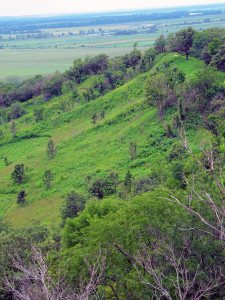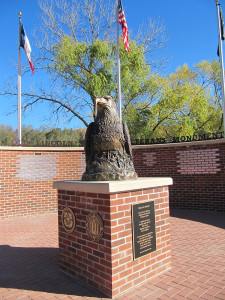Pottawattamie

View of the Loess Hills from Hitchcock Nature Center off the Lincoln Highway in Pottawattamie County.
Pottawattamie County
The land in the county is a black rich loam that allows abundant yields of all types of grain. The Missouri River runs along the western border and only touches the bluffs at one point. It leaves wide bottom lands on the eastern bank with a valley that is 2-10 miles wide and narrows at Council Bluffs. The bluffs skirt the valley and rise 50-300 feet. They are generally clay and sand with a few exceptions where stone is found. There are numerous streams that flow through the prairie in a southwesterly direction and into the Missouri River.
The Loess Hills are made from wind deposited soil and are found in this county to the east of the bluffs and bottom lands. The Hills continue to the north for several counties and to the south near the Iowa /Missouri state border.

Crescent Shea’s Garden Grove ©Francie O’Leary
Buffalo and other game were very plentiful on the prairie. The first fur traders to the area were the French. The Pottawattamie Indians lived in Indiana, southern Michigan and eastern Illinois before coming to Iowa. In 1755, the French, Pottawattamie and other Indians were in a war with England. The Pottawattamie carried on the war even after the French and English made peace and became friends of the colonists’ government.
In 1804, Lewis and Clark started out from St. Louis, MO and traveled up the Missouri River. The Pottawattamie lived in Iowa by this time. The Indians came from all directions to check out the boats and equipment. Lewis and Clark and the Pottawattamie had frequent assemblages of the commanders of the expedition and the Indians. One of these meetings took place at a point near the northwest corner of the county causing that spot to be called Council Bluffs. A fort was erected at or near that spot and for 50 years it was called Council Bluffs.
Once the Pottawattamie figured out their land would be eventually taken by the settlers, they distanced themselves and readied themselves for battle. In the War of 1812, the Pottawattamie took the side of the English. In the Treaty of Ghent, they placed themselves under the protection of the US Government and both sides mutually forgave and forgot their past difficulties. In a treaty on June 5, 1846, the Pottawattamie sold their possessions to the Government and were eventually removed to Kansas. The county was organized in 1848, but the county seat was not very extended in size and “red men were scattered in and about the city in large numbers and several Indian traders occupied tents and small trading posts.”
As the Indians left, the Mormons came and made their winter quarters in Council Bluffs. They named the town Kanesville in honor of Col. Kane from Pennsylvania, who visited the Mormons and was a true friend to them. Some of the Mormons left in the spring and traveled on to Salt Lake City, but some did stay in the Kanesville area.
The 1849 Gold Rush led to Kanesville becoming a noted outfitting post. In 1853, citizens of the county seat, by special act of the General Assembly, adopted the name Council Bluffs and a US Land Office was established that same year.
In 1882, there were 20,000 residents and Council Bluffs became the terminus of the Union Pacific Railway.
Timber was not abundant in the early years, but what was found was mostly cottonwood. If prairie fires could have been prevented for 10-15 years, timber would have been abundant in every Iowa county – even Pottawattamie. Limestone and sandstone was found in the county and brick manufacturing was possible where the best of sand and clay could be obtained. Wild fruit was often found- grapes, raspberries, gooseberries, strawberries, and crab apples. Today the bottomland grass is good for grazing and the rolling hills are usable with the implementation of terrace farming.
Information compiled from History of Pottawattamie County 1882 by W. T. Giles.
Towns on the Lincoln Highway in Pottawattamie County
Loveland
The town was first called Loveland Mills after E. Loveland, the original settler and owner of the town site. He built a sawmill here.
Honey Creek
The settlers named the nearby creek for the many wild bees found there at one time and the town was named for the creek. The Hitchcock Nature Center is located 5 miles north of Crescent at 27792 Ski Hill Loop. $2 per vehicle. 712-545-3283
Named by Brigham Young for the shape of the bluffs surrounding the town, Crescent was settled by many Mormons who did not continue on to Salt Lake City, Utah. Because of the rock bottom, they felt it would be an excellent location for a bridge to be built to Florence, NE and the two towns could out-do Council bluffs/Omaha. After the crash in ’57, houses and businesses were moved from Florence to Omaha and from Crescent to Council Bluffs. Of interest today are the Loess Hills Vineyard and Winery at 1120 Old Lincoln Highway, 712-545-3064 and the Loess Hills Woodworks at 191 Old Lincoln Highway, 712-545-4455.
The Pottawattamie Indians and the Lewis and Clark commanders met here often and called it Council Bluffs. When the Mormon’s moved into the area, they called it Trader’s Point, Hart’s Bluff, and Miller’s Hollow because it was the assemblage point for them to cross the Missouri River. Later they named it Kanesville. As a good number of Mormons left for Salt Lake City, the citizens of the town petitioned to rename it Council Bluffs. Today with Omaha, NE just across the river, there are many things to see and do. Just on the Iowa side alone, there is the 1897 August Beresheim House, Block House Site Marker (built by the Dragoons), California Gold Rush Trail Historic Site, Frontier Heritage Library and Museum, Golden Spike Monument, Grand Encampment/Mormon Battalion Mustering Grounds Marker, and the Great Plains Wing Museum.
Other sites include the Historic General Dodge House, Historic Squirrel Cage Jail, Kanesville Tabernacle and Visitor’s Center, Lewis& Clark Monument Scenic Overlook, Lincoln Monument, Railwest Railroad Museum, Ruth Ann Dodge Memorial, Western Historic Trails Center, and the Loess Hills Lodge Interpretive Facility.
There are 3 casinos (Horseshoe Casino, Harrah’s Casino, and Ameristar Casino) and several vineyards and orchards (Dittmer’s Orchard and Vineyard, Pioneer Trail Orchard and Pumpkin Patch, Prairie Hawk Vineyards, and Welch’s Orchard and Pumpkin Patch).
Art is important in Council Bluffs and can be experienced at the Broadway Fountain (Broadway and Pearl St), Grant Wood Corn Room Memorials (Pottawattamie County Courthouse), Grant Wood Paintings (Iowa Western Community College) Louis Grall Paintings (Pottawattamie Courthouse) and the Sidewalk Mosaics and Streetscape Tiles (Pearl and W Broadway). Another interesting art project is the Eagles of Honor project of handcrafted bronze eagles created by a local couple to thank all the veterans and their families. Eagles have been placed in Avoca, Carson, Carter Lake, Council Bluffs, Crescent, Hancock, Macedonia, McClelland, Minden, Neola, Oakland, Treynor, Underwood, and Walnut. Each eagle is unique.
The Lincoln Highway and Pottawattamie County
As in other counties, the Lincoln Highway followed the railroad. The rail lines were laid first and found the best way to wind through the Loess Hills. In 1928, the Highway was given the number #30. Years later, as a new bridge was built in Harrison County to Blair, NE, the Highway #30 bypassed Pottawattamie County altogether. The original road in Iowa has been identified and signed as the Lincoln Highway Heritage Byway and still travels through Pottawattamie County to Council Bluffs and crosses the Missouri River into Omaha, NE.
Other Towns in Pottawattamie County
- Avoca
The town was first called Pacific by early settlers. In 1869, it became Botno. The Railroad changed it to Avoco from Thomas Moore’s The Meeting of the Waters in which he describes the “sweet vale of Avoca” in Ireland. The historic downtown has been renovated and is well-known for its turrets. Other interesting things in town are the Spider car on S. Chestnut, The Farmall –Land USA Tractor Museum, Eagle of Honor Tribute Statue, the Sweet Vale of Avoca Historical Museum, and the East Pottawattamie County Courthouse (on the National Register of Historic Places) 712-343-2477. The 1875 Octagon House at Graceland Cemetery is also on the National Register. It was originally built to house mourners from inclement weather. 712-343-2477. A fun activity in town is to canoe down the Nishnabotna River.
- Carson
Lash’s Mill was the first name for this town. It was changed to Carson for a railroad official. The Chicago, Burlington, and Quincy and the Chicago, Rock Island, and Pacific railroad joined at this point in 1880. Today, you can stop by Pottery by the Creek and check out Paul Koch’s hand-thrown pottery at 13063 432nd St, 712-486-2324.
- Carter Lake
Carter Lake (the actual lake) is a former channel of the Missouri River and was formed by flooding in the summer of 1877 by the Saratoga Bend in the river. Today it is an oxbow shaped urban lake surrounded by Omaha, NE and Carter Lake, IA near the Eppley Airfield. The City of Carter Lake is in the concave part of the lake and the city of Omaha and Levi Park surround the lake on the convex side of the lake. www.carterlakepreservation.org
- Hancock
The town was originally called Van Armbrusterville and changed to Hancock when F.H. Hancock of Davenport had the town platted in 1880.
The town was named after a county in the Balkan Peninsula found in Biblical references. The town was first used by the Mormons. The Chicago, Burlington, and Quincy railroad had a station here in 1880 and it was named Clayton City. The name was later changed. It was founded on the east side of the Nishnabotna River in 1846. After flooding in 1880, the town was moved to the present location. The Mormon trail winds through town and the nearby country side. A half a mile from town, there is a descent to the river at Olde Town Park where the Mormons crossed the river on a limestone rock ledge. At the Mormon settlement site, on the original Mormon trail, there is a 10,000 pound red granite boulder. Visit the Pioneer Trail Museum at 316 Main St and see the Steeple Bird Collection (300 stuffed birds) at 311 Main (712-486-2323). The town also has one of the last two covered stadiums in Iowa. The town celebrates an annual Nishnabotna River Rubber Ducky Race and an annual Donia Days.
- McClelland
Henry McClelland provided the land for the town. It was established by the Iowa Townsite Company, an affiliate of the railroad, in 1903 when the Chicago and Northwestern railroad came through town.
SCOLA is a non-profit organization that receives and transmits TV programming from around the world in native languages. (21557 270th St). Call 712-566-2022 for tours by appointment.
Minden was name by its German settlers for a town in their native country. The Chicago and Greatwestern and the Chicago, Rhode Island, and Pacific railroads ran through town and helped grow the community. Check out Breezy Hills Vineyard near this town.
- Neola
The origin of the name is unclear. There are towns in Oklahoma and West Virginia with the same name. Some think that Neola is an Indian word that means place of lookout.
The town was first called Big Grove for the timber in the area. It was established in 1882 and renamed for the type of trees in the area. Visit the Nishna Heritage Museum 712-482-6802.
Treynor was named for the Council Bluffs postmaster as an inducement for him to approve a location of a post office here in 1893. It was originally called Four Corners. Treynor Days are held in late June. Visit the Prairie Crossing Vineyard and Winery at 31506 Pioneer Trail, 712-487-3812 and the Butterfly Orchard at 16720 275th St, 712-487-3062
- Underwood
The town was named for the engineer who brought the first train into town on the newly laid tracks of the Chicago, Milwaukee, and St Paul Railroad. www.underwoodia.com
Walnut was named for the fir trees on the Walnut Creek in the area. Originally it was called Walnut Creek Station. When the Rock Island railroad came through in 1868, it was shortened to Walnut. It was incorporated in 1877. It has brick streets, historic buildings and antique and unique specialty shops. In 1985, Governor Branstad gave it the official title-“Iowa’s Antique City.” The Walnut Optimist Club’s Antique City Car Show is held every August and the AMVETS Antique Show and Walk is held over Father’s Day weekend. The Walnut Visitors Center and Gift Shop is a must see. Other interesting places to visit are the Monroe One-Room Schoolhouse at 610 Hyland St (712-784-2100), the Walnut Creek Historical Museum at 304 Antique City Dr (712-784-2100), and the Walnut Mural Tour featuring 27 artists. If you find all the murals, a letter on each spells out “Walnut”.






